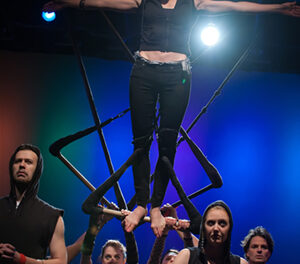A generous program centering on composers who worked for the Esterházys was offered before a small audience in the acoustically admirable Hayes Barton United Methodist Church by the Raleigh Camerata, our region’s newly-minted 501c3 organization offering early music played on period instruments, mostly.* It’s a great pleasure to hear this group and to note its active presence in our community. By and large, most ensembles with this special focus are based at colleges or universities. And it’s a pleasure, too, to observe the overall excellence of these musicians and the high quality of their work together.
On this latest occasion (CVNC having reviewed several earlier concerts by the Raleigh Camerata), the musicians were flutist and ensemble coordinator Kelly Nivison Roudabush, oboist Tom Turanchik, violinists Allison Willet and Matvey Lapin, cellist Eric Perreault, multi-instrumentalist extraordinaire Robbie Link, here playing a handsome violone, (sort of …) a forerunner of today’s double bass, and harpsichordist Jennifer Streeter (playing a 1980 single-manual instrument made by David Sutherland). All these artists have distinguished musical pedigrees, yet this is a true ensemble, as opposed to a collection of stars working from separate points in the stratosphere.
The music centered on Haydn, the most famous of the Esterházys’ hired hands (as musicians were viewed in those days by many of their aristocratic employers), but the program set that master’s works in outstanding context by including scores by mostly long-forgotten colleagues. First up was a short little symphonie (sonata) for two violins and continuo (cello and harpsichord) by Gregor Joseph Werner (b.1693). This seemed fairly typical of lesser-known music from that period, with some appeal for the players, perhaps, but somewhat less to offer listeners. Things picked up considerably with a quintet by Gaetano Pugnani (b.1731) which, according to the excellent and detailed program notes, involved four players – two winds, two violins – and continuo (cello, violone, and harpsichord). This also demonstrated considerable technical and musical progress from the opening work. (One must not get too hung up with counting noses in pieces where continuo players are involved!) This composer is basically unknown, too, although his name will be familiar to fanciers of the violin recordings of Fritz Kreisler, who himself penned some little salon pieces “in the Style of Pugnani.” The quintet came across as a substantial work, immediately engaging and well worth hearing, and for certain its rich sonority must have been a bold revelation when first performed.
There followed a little duet for two violins by Luigi Tomasini (b.1741, and not to be confused with the much later two-“m” Tommasini, the composer of “The Carnival of Venice”). It was fun to think what a pair of virtuoso fiddlers like Szigeti and Milstein might have made of it if they had squared off in an “anything-you-can-do-I-can-do-better” battle of the bows. Here, alas, this was the evening’s weakest link, as the age-old challenges of tuning and intonation plagued the reading. To these ears, the problem seemed to center on the first violin being pretty consistently under pitch.
Part two featured two important early Haydn pieces, a keyboard trio (partita) and a divertimento (cassation) that hinted at the symphonies that were, at roughly the same time, starting to be written. Each of these is the first piece in these forms as listed in the catalog of works by Haydn. And in between was a comparably fine trio by Niccoló Dôthel.
In this part of the program we heard how music blossomed during Haydn’s years at the court. Even these early pieces have variety, depth, emotion, and compelling appeal the other composers did not routinely muster. And many of the keyboard trios are still heard today, albeit generally in modern-instrument incarnations. It was good to experience this early tio on this occasion with original instruments (with Willet playing violin), for the textures were easily perceived and the balances and contrasts were often bracing. In the Dôthel, with Lapin doing the violin honors in company with flute and a three-person continuo group (see what I mean about counting noses?), the playing was every bit as engaging and the ensemble sound took many of us by complete surprise, given its freshness.
The grand finale – and it was very grand, indeed – was the Divertimento in G, H.II:1, which involved every player and in which the two winds came across with particular strength and brilliance. It and the Pugnani were in four movements, with Haydn’s composition somewhat more substantial than one might have expected this early. The strings were consistently reliable here, the harpsichord wove its magic pretty much throughout, and the continuo folks added resonance to the ensemble in very gratifying ways.
There was enthusiastic and well-deserved applause with many members of the audience standing to show their approval.
A note about the music was contained in the program, a helpful adjunct to the proceedings. Not all these scores are in print but many are available from the IMSLP Petrucci Music Library website, a source we CVNCers have from time to time cited in other reviews. Go there to uncover a rich trove of public-domain music from all eras of Western civilization.
The next Raleigh Camerata concert will be on May 1. We’ll have details in our calendar in due course.
If you like this music and this group, please support both!
Finally, I can’t resist saying that if we’d known they were coming up with this program, we’d have baked a torte – since the one named for the Esterházys is among Vienna’s absolute culinary jewels. But since we didn’t, far enough in advance, readers will have to do it themselves, following this recipe.
*The instruments appear to be mostly copies. The cellist used no end-pin but seemed to play with a modern bow, this being the principal departure from the ensemble’s HIP (historically-informed performance) practice.











